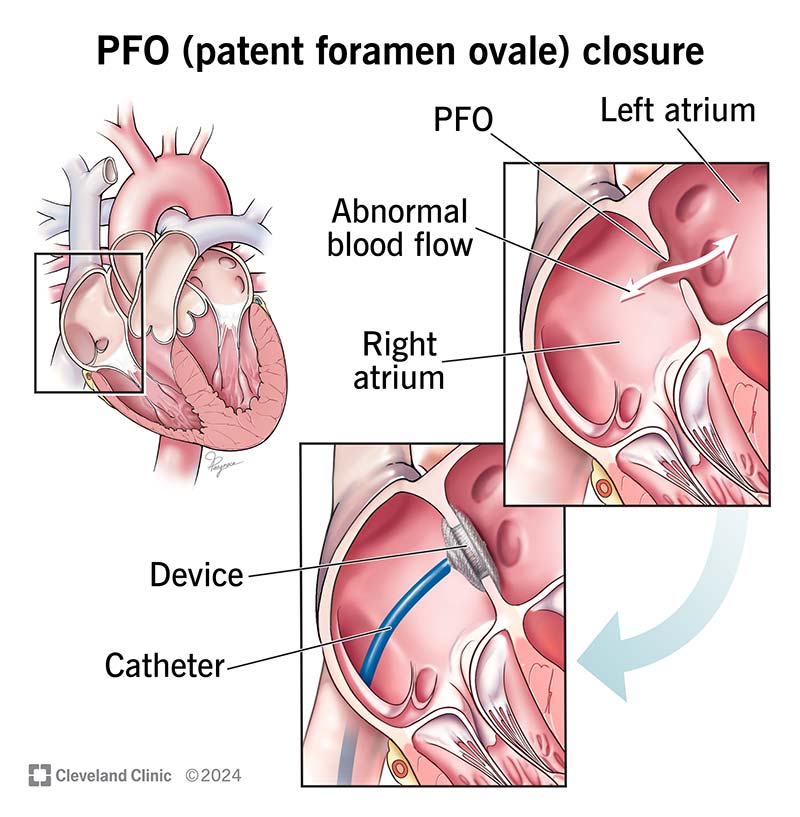Patent foramen ovale (PFO) is a small hole between the upper right and left chambers (atria) of your heart. This hole may let blood flow between the atria. PFO often has no symptoms. Many people don’t need treatment unless they’re at risk of stroke or blood clots. Treatments include medications and closure of the hole with a catheter or surgery.

Patent foramen ovale (PFO) is when you have a small flap or opening between the upper right and left chambers (atria) of your heart. Everyone has this opening, called a foramen ovale, before birth. In most people, this closes after birth. Patent foramen ovale occurs when the flap still exists after birth. “Patent” means “open.”
Most of the time, people with PFO don’t have symptoms and won’t need treatment. But some uncommon problems related to the presence of PFO include stroke and mini-stroke.
Cleveland Clinic is a non-profit academic medical center. Advertising on our site helps support our mission. We do not endorse non-Cleveland Clinic products or services. Policy
A fetus doesn’t use its lungs to get oxygen-rich blood. Instead, this blood comes from the mother’s placenta, delivered through the umbilical cord. A foramen ovale directs the oxygen-rich blood from the umbilical cord in a fetus’s right upper chamber (right atrium) to the left upper chamber (left atrium).
From there, the blood goes to the left side of the fetus’s heart and provides oxygen to fetus’ brain.
The foramen ovale normally closes after birth. This happens when the baby starts to breathe and blood starts to flow to the lungs to get oxygen. This blood then enters the left side of the baby’s heart before getting pumped to the rest of their body.
Anyone can have patent foramen ovale regardless of gender, ethnicity or race. PFO is frequently found in:
Patent foramen ovale affects about 25% of people worldwide. PFO impacts about 30% to 40% of people who’ve had an unexplained stroke. This does not mean that everyone who has PFO will experience a stroke or mini-stroke.
Patent foramen ovale lets a small amount of blood flow between the flaps connecting your right and left atrium. Normally these flaps stop blood from flowing between them.
Usually, patent foramen ovale causes no problems. But PFO may let a blood clot travel from the right to the left side of your heart. Your heart could pump the clot into your body. If the clot reaches your brain, it could cut off the blood supply. This would cause an ischemic stroke. The clot may also damage your other organs, such as your kidneys or your heart.
Researchers don’t know what causes patent foramen ovale.
Most people will not have any signs or symptoms directly from PFO at all. Possible PFO symptoms include:
Less common conditions people may experience include:
Your healthcare provider will first ask about your symptoms and do a physical exam. If your provider suspects PFO, they may recommend the following tests:
Your provider may also suggest a bubble test, along with an echo or TCD ultrasound. During a bubble test, they inject saltwater solution into your vein. You may have PFO if your lungs don’t filter out the bubbles and they travel through the hole to your left side of your heart.
Most people with patent foramen ovale won’t need treatment. But your provider may recommend treatment if you have a history or high risk of strokes or blood clots. Treatments for PFC include:
Recent research suggests that PFO closure may help prevent future strokes in people with PFO who’ve had an unexplained stroke. Talk to your provider about which treatment may be right for you.
Treatments for patent foramen ovale may cause complications in some people. Complications vary depending on the type of treatment:
Complications of taking aspirin or warfarin may include:
Common complications of the catheter procedure may include:
Less common complications of catheterization may include:
Complications from surgery to close the PFO may include:
You can’t reduce your risk of PFO. But you should get tested for this condition if you have an unexplained (cryptogenic) stroke. That way, you can get prompt treatment if needed.
Many children with PFO find the flap seals completely on its own during their first three years. Many people who still have PFO as adults lead long, full lives.
You can keep your heart healthy and reduce your risk of stroke by:
You can also reduce your risk of blood clots by not standing or sitting in the same position for too long.
See your provider immediately or call 911 if you have any stroke symptoms. These symptoms may include:
A note from Cleveland Clinic
Patent foramen ovale (PFO) is a small communication between the upper right and left chambers of your heart. PFO affects about 25% of people. PFO often doesn’t cause any symptoms and may not require treatment. But it can sometimes indicate stroke or mini-stroke. If you have a history of stroke or blood clots, your provider may suggest treatment. Treatments include medications, catheterization and surgery. Most people with patent foramen ovale can lead full lives.
Last reviewed by a Cleveland Clinic medical professional on 07/15/2022.
Learn more about our editorial process.
Cleveland Clinic is a non-profit academic medical center. Advertising on our site helps support our mission. We do not endorse non-Cleveland Clinic products or services. Policy